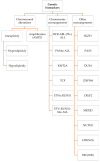Genetic Biomarkers and Their Clinical Implications in B-Cell Acute Lymphoblastic Leukemia in Children
- PMID: 35269896
- PMCID: PMC8911213
- DOI: 10.3390/ijms23052755
Genetic Biomarkers and Their Clinical Implications in B-Cell Acute Lymphoblastic Leukemia in Children
Abstract
Acute lymphoblastic leukemia (ALL) is a heterogeneous group of hematologic malignancies characterized by abnormal proliferation of immature lymphoid cells. It is the most commonly diagnosed childhood cancer with an almost 80% cure rate. Despite favorable survival rates in the pediatric population, a significant number of patients develop resistance to therapy, resulting in poor prognosis. ALL is a heterogeneous disease at the genetic level, but the intensive development of sequencing in the last decade has made it possible to broaden the study of genomic changes. New technologies allow us to detect molecular changes such as point mutations or to characterize epigenetic or proteomic profiles. This process made it possible to identify new subtypes of this disease characterized by constellations of genetic alterations, including chromosome changes, sequence mutations, and DNA copy number alterations. These genetic abnormalities are used as diagnostic, prognostic and predictive biomarkers that play an important role in earlier disease detection, more accurate risk stratification, and treatment. Identification of new ALL biomarkers, and thus a greater understanding of their molecular basis, will lead to better monitoring of the course of the disease. In this article, we provide an overview of the latest information on genomic alterations found in childhood ALL and discuss their impact on patients' clinical outcomes.
Keywords: ALL; B-ALL; T-ALL; biomarkers; childhood acute lymphoblastic leukemia.
Conflict of interest statement
The authors declare no conflict of interest.
Figures
References
-
- Khazaei Z., Goodarzi E., Adineh H.A., Moradi Y., Sohrabivafa M., Darvishi I., Dehghani S.L. Epidemiology, Incidence, and Mortality of Leukemia in Children Early Infancy to 14 Years Old of Age in South-Central Asia: A Global Ecological Study. J. Compr. Pediatr. 2019;10:e82258. doi: 10.5812/compreped.82258. - DOI
-
- Ferlay J., Ervik M., Lam F., Colombet M., Mery L., Piñeros M., Znaor A., Soerjomataram I., Bray F. Global Cancer Observatory: Cancer Today. [(accessed on 6 January 2022)]. Available online: http://gco.iarc.fr/today/home.
-
- Namayandeh S.M., Khazaei Z., Lari Najafi M., Goodarzi E., Moslem A. GLOBAL Leukemia in Children 0–14 Statistics 2018, Incidence and Mortality and Human Development Index (HDI): GLOBOCAN Sources and Methods. Asian Pac. J. Cancer Prev. APJCP. 2020;21:1487–1494. doi: 10.31557/APJCP.2020.21.5.1487. - DOI - PMC - PubMed
Publication types
MeSH terms
Substances
LinkOut - more resources
Full Text Sources



